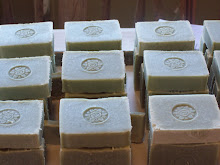Friday, February 26, 2010
Why do I fall for it every time?
I must really love that dog.
Wednesday, February 24, 2010
Tuesday, February 16, 2010
Thyme

Growing
Thyme is a low-growing, woody perennial. Although the upright varieties grow to around 12 – 15”, some varieties are creepers, and very low growing. It needs lots of sun and very well drained soil. It makes an excellent edging for borders, or in between stepping stones. The smaller varieties handle foot traffic well, and can even be planted instead of grass in certain areas of your landscaping. You can get a variety of “flavors” and colors, ranging from yellow to grey/green to bright green. Thyme blossoms are tiny and happy and one of my favorites in the herb garden – they’re just so stinkin’ cute!
Harvesting
Cut small stems from around the plant – just take care not to cut all the leafy bits from one stem or area or your plants will start to look sparse and sad! If you give your thyme a “haircut”, without cutting the whole stem, it will keep growing nice and full. It will keep nicely for over a week in the fridge if you keep in sealed baggie. Thyme, though, is one of the best herbs for drying because it doesn’t lose its flavor in the drying process. You can harvest in small bunches and hang to dry, or you can try drying it on the stem in a food dehydrator, which I’ve had good success with. You just need to make sure the temperature isn’t set too high.
Medicinal
Thyme has antiseptic and antifungal properties, and is used frequently in salves and teas. It has been used to treat everything from depression to asthma to spastic colon! However, since this is not a medicinal herb site, and I am not an herbalist, I’m going to leave all of the prescribing for someone else to do. I will leave you with this recipe that I use. I found this in a forum years ago, and can only give credit to the forum member who posted it – thanks, Soraya! This is her post, so the “I” in this recipe refers to her…
Soraya’s Raspberry Sore Throat Elixir
Proportions are not too critical in this…so you don’t have to be too precise.
Red Raspberries (fresh or frozen, no sugar)
Apple Cider Vinegar
Thyme (fresh or dried)
Honey
A glass (not plastic, not metal) container.
Put raspberries in container and then cover completely with enough apple cider vinegar. (I use a glass pitcher for this, normally pouring the cider in to go at least an inch or two over the top of the berries.)
Add a good amount of thyme. (I normally use fresh, and use about one whole small plant say, 1 cup leaves (and all but the very thick stems) loosely packed.)
Give it a good stir and place in fridge for two weeks, shaking or stirring once daily. (Now, if you want to get magikal here, while you are shaking it, you could repeat a short charm or verse of your liking, or even direct simple healing energy into it. You Reiki folks might use that?)
After it has seeped for the 2 weeks, take it out and strain into a saucepan. Heat to a simmer (DO NOT BOIL) while adding the honey to taste. (This really doesn’t taste to bad to begin with, and honey does have anti bacterial properties…so be liberal with it.)
Funnel into sterile jars and store in the fridge. (I’ve kept a jar up to 18months, but I like to make this yearly if possible.)
For use, gargle every 4 to 6 hours the first tickle of a sore throat (for 45 seconds to a minute at least.)
Cosmetic
Thyme oil is used in many things from cough drops and toothpaste to detergent and perfume. It is also said to be good for treating dandruff and oily hair, and for treating wrinkles! As with any essential oil, though, use caution – essential oils, especially thyme oil, are very potent and should only be used after diluting in a carrier oil, such as apricot kernel or olive oil. Do your research or speak with an herbalist to determine the strength you need.
Culinary
“English thyme is indispensable when making stocks. If you leave it out, it’s like making a cake without vanilla – it tastes okay but a bit flat, and you know something is missing.” Jerry Traunfeld, The Herbfarm Cookbook
Thyme is one of those herbs that fits well with many, many things. Great with meats and vegetables, it also goes really well with cheeses and eggs. It’s even used in some wines! One of the herbs in bouquet garni (with parsley and bay), it goes well with many other herbs such as rosemary, oregano, chives and sage. Unlike some of those herbs, it’s hard to get too much thyme in a dish, so you can be a little more liberal with it than you could, say, rosemary. One of my favorites is lemon thyme (see photo above), which I use quite often to flavor chicken and soups. Get several varieties of thyme and have fun experimenting!
Jean









